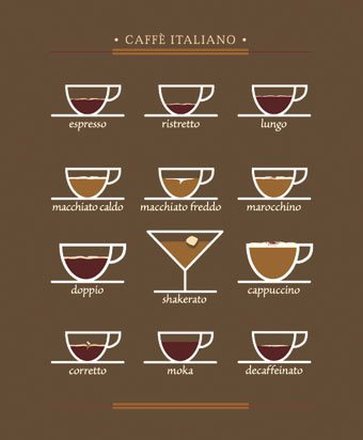Together with music and food, Italian culture offers many other particularities typically italian:
ITALIAN GESTURES / ITALIENISCHE GESTIKULATION / GESTI ITALIANIItalians, with their innate passion to communicate, have never let words get in the way. In Italy the shrug of a shoulder, the flip of a wrist or the lift of an eyebrow says more than a lot of words. Gestures are to Italian conversation what punctuation is to writing. Hands become exclamation points, periods, commas, question marks. Questo è un video sui gesti italiani con sottofondo musicale pubblicato dal Consolato degli Stati Uniti a Milano per insegnare agli statunitensi che vengono in Italia i gesti fondamentali per comunicare. |
|
THE ART OF DRINKING COFFEE / DIE KUNST DES KAFFEETRINKENS / L'ARTE DI BERE IL CAFFÈ
Espresso, caffè normale, cappuccino; sometimes it seems that there are as many types of coffee in Italy as there are pastas. And just like pasta, Italian coffee is an art form with many customs and traditions. Whether it's a caffè corretto thrown back like a shot, a cappuccino and brioche for breakfast, or a granita di caffè con panna to cool off from the hot midday sun, in Italy there is a coffee drink specific for every time and mood.
If you don't want to be labeled maleducato, when ordering a coffee in Italy it's "espresso", not "expresso". Both will quicken your heart rate, but an "expresso" is a fast train and an "espresso" is a small cup of very strong coffee. And "caffè" (with two f's) is both the beverage and the locale that serves it.
Keep in mind too, Italians generally don't drink coffee with any meal except breakfast. Coffee is often ordered after a meal, and only the unwitting tourist will order a cappuccino in a restaurant after lunch or dinner. When ordering an after-dinner coffee, do not ask for an espresso, ask for "un caffè, per favore."
Below is a list of the most popular caffeine-laden drinks:
If you don't want to be labeled maleducato, when ordering a coffee in Italy it's "espresso", not "expresso". Both will quicken your heart rate, but an "expresso" is a fast train and an "espresso" is a small cup of very strong coffee. And "caffè" (with two f's) is both the beverage and the locale that serves it.
Keep in mind too, Italians generally don't drink coffee with any meal except breakfast. Coffee is often ordered after a meal, and only the unwitting tourist will order a cappuccino in a restaurant after lunch or dinner. When ordering an after-dinner coffee, do not ask for an espresso, ask for "un caffè, per favore."
Below is a list of the most popular caffeine-laden drinks:
|
ITALIAN FOLK DANCE / ITALIENISCHE VOLKSTÄNZE / DANZE POPOLARI ITALIANE
|
Italian Folk Dance has been an integral part of italian culture for centuries. One of the most famous italian dance ist the Tarantella. The term Tarantella groups together a number of different folk dances characterized by a fast upbeat tempo, accompanied by tambourines. It is among the most recognized forms of traditional southern Italian music.
In Italian culture, the word “tarantella” evokes images of a frenzied spinning dance traditionally played at weddings. However, this popular native dance of Southern Italy has a history and myth spanning several centuries. The dance, originally an Italian folk dance of the lower- and middle-classes, has been labeled as a dance to cure sickness and as a dance of courtship. In the courtship version of the dance, the woman uses rapidity and liveliness to excite the love of her partner. In turn, the man tries to charm her with his agility, elegance and demonstrations of tenderness. The dance is one of unity and separation, which sees dancers flying into each other’s arms only to bound away again. It is considered unlucky to dance the Tarantella alone so it is often danced by couples or by two women. |
|

